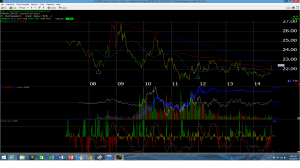
I do wish there was a better way to track or trade the US dollar, but for the last few years, I’ve watched the UUP or the PowerShares Dollar Bull ETF, which consists of a DeutscheBank Long US Dollar Futures Index.
The weighting of the basket is critical. According to this write up found on the Invesco website (date unknown), the UUP consists of contracts or weights on the following currencies in the following percentages:
- Euro – 57.60%
- Yen – 13.60%
- British Pound – 11.90%
- Canadian dollar – 9.10%
The weights fall sharply from that point.
Today’s big news was on the British Pound, which fell sharply after a pre-vote survey revealed that Scotland might vote themselves out of the UK. I don’t know if you call it secession or abdication, but Scotland seemingly wants independence from England and the British Empire.
All three of the top-weighted currencies have suffered weakness over the last few years, first starting with the yen and shinzo Abe’s election, which has weakened the yen from near 80 to today’s 104 level, to Euro’s weakness of late (the Euro traded as high as 137.50 – 138 in mid March to early May ’14), and then today’s action in the Pound.
After having waited for years for the dollar to rally, (and it seems like it has been weak since early in the Bush Administration) we could be in the early stages of a long-term dollar strengthening, particularly as the 10-year Treasury yield, which closed at 2.46% today, has a higher yield than many 10-year sovereign credits.
Note on the above chart how the UUP is trading above its 200-day weekly average for the first time in early 2013, but the ETF is also approaching the downtrend line off the 2009 and 2010 highs. Volume was heavier in the UUP today, with today’s trading volume at 1.14 ml shares traded versus the longer-term average of 868 million.
Discussions about the dollar, inflation and the Fed can often make the writer look very smart, but often lead nowhere in terms of investment usefulness.
Watch the UUP and how it trades around the downward sloping trend-line. If you see a higher volume move above the trend-line, readers can use the UUP to hedge some of their Consumer Staples/Discretionary and Industrial longs. Where dollar movements tend to have the biggest impact on financial results is with companies that are mid-single-digit secular growers, like a Procter & Gamble (PG) or Philip Morris (MO) or the soup or cereal companies.
Also remember too, that currency impact is at first translational, but it takes a long time to be “economic”. Think back to the mid 1980’s and President Reagan’s strong dollar policies. The strong dollar caused a tremendous amount of capital to flow into America, but after a year or two the dollar strength began to create the Rust Belt, and decimated large US exporters, like the steel companies, and the Midwest manufacturing belt.
Don’t overestimate the dollar’s importance, but don’t underestimate it either.
A strong move above that trend-line for the UUP and I do think we have entered a new phase for the US dollar, particularly if interest rates start to rise. The 10-year Treasury today, despite the relatively weak equity market, closed above the 2.45% level again this afternoon.
Thanks for reading. Not sure we are on the cusp of anything significant, but it pays to pay attention.
Trinity Asset Management, Inc. by:
Brian Gilmartin, CFA
Portfolio manager
